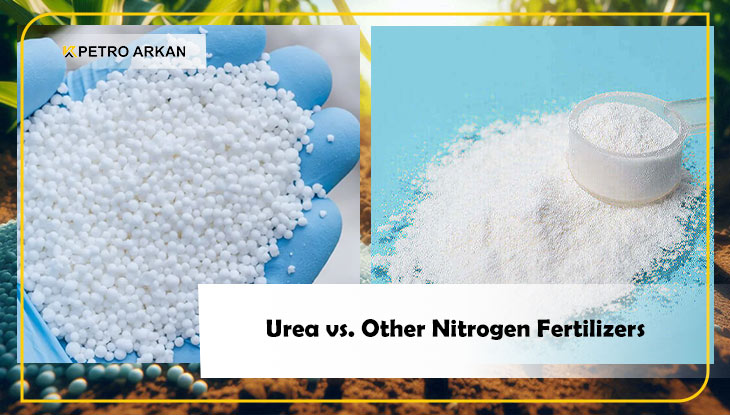Introduction to Urea vs Other Nitrogen Fertilizers
Selecting between Urea vs Other Nitrogen Fertilizers is crucial for enhancing crop nutrition and yield. Urea, with its high nitrogen content, competes with alternatives like ammonium nitrate (AN) and calcium ammonium nitrate (CAN). PetroArkanCompany explores the benefits, drawbacks, and applications of Urea vs Other Nitrogen Fertilizers to guide farmers in achieving fertilizer efficiency and soil fertility.
Understanding Nitrogen Fertilizer Forms
Urea
Urea, a white, crystalline solid with 46% nitrogen (NPK 46-0-0), is a leading nitrogen source. In Urea vs Other Nitrogen Fertilizers, urea undergoes a three-step process in soil: conversion to ammonia, then ammonium, and finally nitrate, typically within 2–4 days under optimal conditions. Its high solubility makes it ideal for rapid nutrient delivery in agricultural applications.
Other Nitrogen Fertilizers
Alternatives like AN, CAN, ammonium sulfate, and calcium nitrate vary in nitrogen content and stability. In Urea vs Other Nitrogen Fertilizers, nitrates (e.g., in AN) are prone to leaching in sandy soils, while ammonium-based fertilizers (e.g., aqua ammonia) require subsurface application to prevent volatilization, impacting their fertilizer efficiency.
Benefits and Drawbacks
Advantages of Urea
In Urea vs Other Nitrogen Fertilizers, urea offers:
-
Cost-Effectiveness: High nitrogen content reduces application and transport costs.
-
Versatility: Suitable for various crops, enhancing crop nutrition.
-
High Nitrogen Delivery: 46% nitrogen ensures efficient nutrient supply with less product.
Disadvantages of Urea
Urea’s drawbacks include:
-
Volatilization Risk: Improper application can lead to nitrogen loss in warm, moist conditions.
-
Soil Acidification: Prolonged use may lower soil pH, requiring pH management.
Other Fertilizers
Alternatives like AN pose environmental risks (e.g., water pollution, explosion hazards), while CAN and ammonium sulfate may be costlier but offer stable nitrogen release in Urea vs Other Nitrogen Fertilizers.
Why Choose PetroArkanCompany?
PetroArkanCompany provides high-quality, prilled or granular urea, ensuring consistent fertilizer efficiency for diverse crops. Their products support precise application, minimizing losses and enhancing soil fertility.
Conclusion
Choosing between Urea vs Other Nitrogen Fertilizers depends on cost, crop needs, and soil conditions. Urea’s high nitrogen content and affordability make it a top choice, though proper application is key to prevent volatilization. PetroArkanCompany’s premium urea ensures optimal crop nutrition and sustainable farming success.
FAQ
Why is urea cost-effective compared to other nitrogen fertilizers?
Urea’s 46% nitrogen content requires less product, reducing transport and application costs.
What is the main disadvantage of urea?
Urea risks volatilization if not applied correctly, leading to nitrogen loss in warm, moist conditions.
How does urea compare to other fertilizers for crops?
Urea’s versatility suits various crops, while alternatives like AN offer stable but costlier nitrogen release.
How can urea volatilization be minimized?
Apply during cooler times (early morning/late afternoon) and incorporate into soil.
Where can I source high-quality urea?
PetroArkanCompany offers reliable, high-purity urea for effective nitrogen sources.








No comment